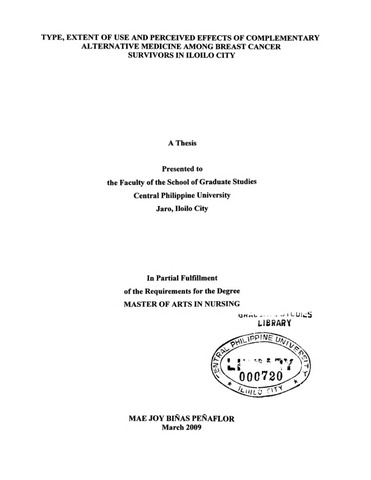| dc.description.abstract | This study determined the type, extent of use and perceived effects of complementary alternative medicine among breast cancer survivors in Iloilo City.
The respondents of this investigation were all the 44 breast cancer survivors, who are members of the Bosom Friends Incorporated, Iloilo City.
This is a qualitative and quantitative study.
A self-administered instrument and a personal interview were done to those who have difficulty in answering the research instrument. Appropriate statistics were used in the analysis of description, differences, and relationship using the statistical package for the social sciences (SPSS).
Major Findings
1. Majority of the respondents were above 50 years old, married, and belong to high income group. Most of them had attained college education, were employed, and were diagnosed to have breast cancer for less than nine years. Furthermore, similar percentages were noted in all stages of breast cancer. Majority of them have no history of breast cancer. The mean age is 56.4.
2. Majority of them had undergone surgery and chemotherapy. Less than one-half of the respondents had undergone radiation.
3. There is no significant difference between all types of complementary and alternative medicine and the respondents’ age.
4. There is a significant difference between special diet and nutritional supplement and the respondents’ civil status. The Z test of 2.053 is significant at .05 percent level. However, no significant differences were noted between spiritual healing and prayer, relaxation techniques, and counseling.
5. There is a significant difference between special diet and nutritional supplement and the respondents’ educational attainment. The Z test result of 2.772 is significant at .05 percent level. However, no significant differences were noted between spiritual healing and prayer, relaxation techniques, and counseling.
6. There is no significant difference between all types of complementary and alternative medicine and the respondents’ family monthly income.
7. There is no significant difference between the proportions of both working and not working respondents and the use of complementary and alternative medicine.
8. There is no significant difference between all types of complementary and alternative medicine and the respondents’ stage of breast cancer.
9. There is no significant difference between all types of complementary and alternative medicine and the respondents’ length of illness.
10. Majority of the respondents had experienced improved effects on special diet and nutritional supplement in all aspects.
11. Majority of the respondents had experienced improved effects on relaxation techniques in all aspects. Only a few had experienced no effect after the therapy.
12. Most of the respondents had experienced improved effects on counseling in all aspects except educational attainment, family monthly income, and stage of illness.
13. In terms of physiological effects of complementary and alternative therapy, respondents verbalized that they experienced a change in their physical state such as increased energy and physical strength, reduce muscle stiffness, reduced nausea and vomiting, increased appetite, prevent constipation, and increased concentration. However, others would experience no improvement after subjecting themselves to use CAM.
14. In terms of psychological effects of complementary and alternative therapy, most of them had experienced positive improvement.
Conclusions
In the light of significant findings of the study, the following conclusions are drawned:
1. Majority of the respondents used spiritual healing and prayer, special diet and nutritional supplement, relaxation techniques, and counseling.
2. There is a significant difference between special diet and nutritional supplement and the respondents’ civil status. This means that the civil status of the respondents greatly affects the use of special diet and nutritional support.
3. There is a significant difference between special diet and nutritional supplement and the respondents’ educational attainment. This means that educational attainment strongly affects the use special diet and nutritional supplement.
4. Improvement on condition of breast cancer survivors were found out after the use of complementary and alternative medicine.
5. In terms of physiological and psychological effects of complementary and alternative therapy, most of the respondents had verbalized an improvement on their condition.
Recommendations
Based on the results of the study and the conclusion derived from the study, the researcher presents the following recommendations:
Breast Cancer Survivors. Breast cancer survivors should have adequate information on the use and effects of complementary and alternative medicine before using the said therapy to improve their health condition and improve their quality of life.
Department of Health. The Department of Health should have a more comprehensive approach in the information dissemination of the different types, used, and methods of complementary and alternative therapy.
Health Care Providers and Health Educators. This renders a more challenging responsibility mostly in the dissemination of accurate information and correct usage of complementary and alternative therapy to improve the condition of breast cancer survivors. Further, it is also recommended that they help in the researching, designing, and presenting promotive and preventive health care programs on complementary and alternative therapy.
Student Nurses. Student nurses should also help in information dissemination regarding correct health teachings regarding complementary and alternative therapy.
Future Research. This may serve as a guide to other researchers in making follow up studies so that eventually new ideas may be created. | en_US |


